
Build Your Own DIY Tandoor Oven from Flower Pots
++++++++++++++++++++++++ EDITING +++++++++++++++++++++++++++++++
Now if you want to build yourself a tandoor, then this is the one to build, and the one I always recommend for first timers. It is easy to make, practical & versatile, and believe me you will be using it all the time. Simple to use and you could be cooking in 20 minutes, ideal if you are rustling up a quick spot of lunch. 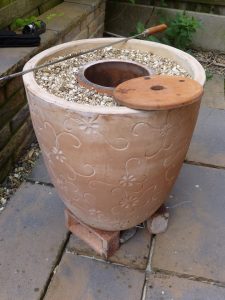 As I write, I made this Tandoor over 4 years ago and I am still using it as originally made with no modification. Note it is also the same pots and insulation, nothing has been replaced. Sure there are a few cracks in the inner pots, and the bottom inner pot has broken away, but it doesn’t affect the cooking. See the section below on cracks and broken pot
As I write, I made this Tandoor over 4 years ago and I am still using it as originally made with no modification. Note it is also the same pots and insulation, nothing has been replaced. Sure there are a few cracks in the inner pots, and the bottom inner pot has broken away, but it doesn’t affect the cooking. See the section below on cracks and broken pot
The hardest part of this this build is finding the large outer pot. There are not many large pots around, and they also come with a price premium. So just keep your eyes open and look out for those half price pot sales. I brought my large pot at a local garden center at the end of summer. Once I had my large pot I needed to find two pots to fit inside to make the core oven. To do this I just walked around the garden center trying out different size pots until I got the size and shape I wanted. No real science here just go with what looks right and what meets your needs. For me I wanted a wide opening so I could get more food in, but have enough of a gap between the inner and outer pots for good insulation. So to make the Tandoor oven, start with the large outer pot and at the bottom of this put a ring to keep the inner and outer pots from touching. I made my ring by cutting the bottom off an old broken pot, there is another video showing that being made. Next I put the first inner pot inside, having previously drilled extra holes in the bottom to improve air flow. This is then followed by the next pot being place upside down on the first pot. Note I had cut the bottom off this pot, and this makes the opening for my Tandoor. Finally I fill the gap between the inner and outer pots with Insulation, and that’s it. OK did I explain that well or are you confused?. They say a picture is worth a thousand words, so here is a short minute video explaining how to build.
Drawing Video
Hopefully you have read the Small Tandoor build or watched the video as this is similar, but scaled up. The main differences are as follows:
- Wider opening at the top which now enables me to cook naan
- Capacity has increased so I can now cook four large skewers as well as fish and steak on the grate in the middle
- I now have a ridge going around the middle inside of the oven to rest my skewers on.
This Tandoor should take you 30-60 to make, and then you could be cooking 20 minutes later. Still not convinced? OK watch this video of me making this Tandoor for the very first time.
If you watch the video you saw I made this Tandoor in minutes. My in-laws were having a BBQ so I took the kit with me and built the Tandoor there. The only thing you didn’t see is me cutting the top off one of the pots, and cutting the ring. I did this at home with the angle grinder and it took between 5-10 minutes. I would recommend using an angle grinder as it is so much easier, and quicker. Angle grinders can be a bit scary, mainly because of the noise. But when handled properly they are a joy to use. Here is a video I did cutting a pot and making a ring for a friend:
Video angle grinder
Is it a Tandoor Oven or a Tandoori Oven?
This is a confusing one, but as far as I understand it Tandoor is the oven and Tandoori is the food you cook in the oven. For example Tandoori chicken is cooked in a Tandoor oven.
Build your Own Tandoor Frequently Asked Questions
Now for the list of frequently asked questions that came out of this build.
Tandoor Build FAQ – Cleaning
Tandoor Build FAQ – What size are the pots
Another common question I get is what size are the pots, in this example they are as follows:
Outside pot = 52cm high x 52cm diameter at the top.
Inside bottom pot = 22cm high x 27cm diameter.
Inside top pot = 25cm High x 27cm diameter.
From the emails I get most people go to DIY stores to buy their pots, but I prefer Garden Centres as there is a lot more choice. I decide on the big pot first, and then walk around placing smaller pots inside until I get the best fit.
Tandoor Build FAQ – Tandoor oven does not get hot
Gopal picture
Tandoor build FAQ – What is the insulation you use and what is best insulation for a Tandoor oven?
The next popular question is what is the insulation you use and where do you get it from. I use vermiculite which is a fire proof insulation. In the UK you can get it from builders merchant, fire place stores as well as garden centres and some DIY stores. I found the best price from builders merchants and Ebay as can get large 100l bags.
Some people have used perlite and have been pleased with the results. I might be tempted to give that a go next time, but more than happy with the vermiculite.
I have seen examples of people using clay beads, stones or small rocks for insulation. They have said it does give some insulation, but they struggle to make the really high internal temperatures.
Another common insulation people use is sand, and I hear mixed reviews. Some people are perfectly happy with the results from sand, where as others have had the outer pot crack. I am guessing because so much heat is transferred to the outer pot.
Personally knowing how hard it is to find a good large outer pot and at the right price, I would not risk using sand. As I write this my oven is 3 1.2 years old and there are no signs of cracks on the outside pot. I can be cooking all day and still the side are at a normal temperature.
Tandoor build FAQ – Cracked pots
This brings us on nicely to do I have a problem with cracked pots. For the outer pot – No, see my last comment about insulation. For the inner pots I have had cracks. The top inner pot was perfect for 2 1/2 years, then one day I overloaded the oven with charcoal. To make matters worst the oven was damp. The oven shot up higher than it have ever been. To give you an idea my temperature gauge goes up to detail and pic, the temperature gauge went up to detail, the temperature went off the scale and the glass cracked. So I have no idea what the final temperature was, but I think I basically had a furnace. Needless to say the pot cracked, and all down to my stupidity. On a positive note I have a lesson learnt and something to share with you. Saying all that the crack has not affected the performance of the oven and I am still using it to cook with. I have attempting repairing it, but the crack still appears when the oven gets hot. But as I say it does not affect the performance and I still use it the same as before. As always I made a video of the repair. more on bottom crack
Tandoor build FAQ – Lighting
Tips on Building a Homemade Tandoor from the Community
I one thing I love most about this website or my YouTube channel is the interaction I get. People are always keen to share their build experiences with the wider community, and share tips on how they improved on my build. I have tried to incorporate these in the article above, but here are some others that are worth highlighting:
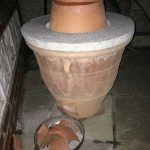 Now this tip came from Gopal, lots of people put larger stones or chipping on top of their oven to stop the insulation blowing away. Gopal went one step furhter and made a stone top out of a paving slab. Basically he got an angle grinder and cut it into shape. I think it looks really attractive, plus it also helps keep the rain off.
Now this tip came from Gopal, lots of people put larger stones or chipping on top of their oven to stop the insulation blowing away. Gopal went one step furhter and made a stone top out of a paving slab. Basically he got an angle grinder and cut it into shape. I think it looks really attractive, plus it also helps keep the rain off.
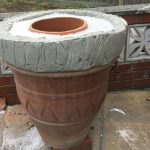
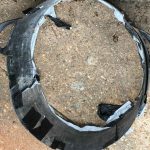 Another top tip from Gopal, he originally had trouble buying a large pot for his oven so he brought the biggest he could find and then increased the height by adding a concrete ring. He used an old bucket to make the shape. I haven’t seen the final oven but he had planned to decorate the concrete possibly with a mosaic tile pattern.
Another top tip from Gopal, he originally had trouble buying a large pot for his oven so he brought the biggest he could find and then increased the height by adding a concrete ring. He used an old bucket to make the shape. I haven’t seen the final oven but he had planned to decorate the concrete possibly with a mosaic tile pattern.
grate
top pot for naan

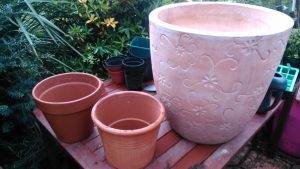
Recent Comments